· 12 min read
Generative Music and the Meter of Nowness

Written by Max Alper
The following was originally given as a live lecture and demonstration for students and patrons of the La Meme Young online classroom in early 2021. The original lecture was released to the general public in the Summer of 2021 as both a podcast and Youtube livestream video with no edits made to the original. It has since been read and demonstrated as a live lecture at Nowadays in Brooklyn in 2022, and has now been transcribed and edited for essay format with additional editorial materials added by the author.
When I discuss the technicalities of generative music, what we're talking about here is repetitive, sequential, or loop-based electronic music made through generative, rather than gestural, instrumentation. We can spend all day listing styles of music that maximalize the usage of generative instrumentation, but for the sake of brevity we will focus on two genres that clearly illustrate priority for this instrument category: Techno and Ambient musics, respectively.
The technical and musical languages of both genres contain a common element. Both often share the use of generative instrumentation: electronic interfaces that rely on onboard programming in correlation to the creation of sound. This is held in contrast to traditionally performed, physically gestural instruments, such as keyboards and drum pads. If a sound is performed live on a keyboard, pad, or fader during an Ambient or Techno composition, the usual expectation is that the sound will then repeat through generative playback mechanisms such as a sequencer or arpeggiator.
Obviously, there are exceptions to these rules across the entire generative music spectrum. Some of the best live practitioners of these styles combine a practice of live gestural performance in conjunction with preprogrammed generative elements, it’s what can make “live” electronic music so exciting. If you haven’t watched an Underground Resistance live set with full brass and rhythm sections on Youtube before, stop reading this and go do that now.
But for the sake of laser focusing on technology-aided spontaneity, we're going to be specifically talking today about what it means to use generative instrumentation beyond a predetermined meter or even compositional structure. Specifically, we are going to explore the usage of a generative clock and of reducing large rhythmic phrases down to the individual pulse. How can we turn large sections into a series of single bursts of rhythmic voltage? I call this technique Clocked Randomization, but even more so poetically as The Meter of Nowness.
We use the word Trance as a subgenre term in Techno, but the idea of making music that is an all-encompassing, out-of-body experience that doesn't necessarily demand you to “pay attention” to the macrostructure of the composition extends far beyond the Techno vocabulary. You’re just as likely to be entranced by Trance music as you are by Meshuggah polyrhythmic djent breakdowns or Georgian Orthodox hymns.
Sometimes we achieve this state by being presented with various rhythmic paths, multiple meters, and layers of thick saturation and effects. The act of deciphering these paths becomes a meditative dance on the floor at the club, it truly is a moment of nowness. When the timing is right, it’s just you, the dance floor, the sound system, and the DJ or live act in perfect synchronized unity. The space and the moment, then and there, become prioritized over simply the track being played at loud volumes.
The four to the floor is one of many vehicles, but it is not the destination.
This “nowness” is crucial within the context of ambient music theory a la Brian Eno as well. Ambient as a genre has always encouraged the listener to “ignore” the music as a whole as a means of focusing on the enveloping space it puts you in right here and now. Eno first coined the term Ambient music in the 1970s but was himself directly inspired by Erik Satie’s theory of Furniture Music.
In 1917, while still living in the exclusively acoustic age of composition, Satie conceptualized a chamber music concert experience consisting of performers spread through a salon space during the performance, rather than having them centralized on a single stage or performance area. Concertgoers were encouraged to ignore the music as if it were furnishings on the walls and floors of the space and not performed by live musicians standing right next to them while they sip vermouth. Many cite this concept as the first instance of background music, composed specifically to be played in the background, inspiring just as much Muzak as it did Ambient music throughout the 20th century.
Honing in on this “ignorability” in my own music, I first coined the term “Meter of Nowness” in 2019 with the release of my compilation of generative electronic compositions entitled Electronic Music That Has Rhythm. The record itself is an exploration of the trancelike experience while listening to repetitive & generative music, while staying in my lane and not going so far as to call it a Techno or an Ambient record. The following is taken directly from my artist statement I released in accompaniment to the record:
“Electronic Music That Has Rhythm”, simply put, is what it is. While much of my work revolves around the use of single-take, live improvised electronic recordings produced from my home, it often falls under the umbrella of “arrhythmic” electronic music: electro-acoustic, concréte, noise, ambient, etc. Too often we see rhythm and tonality seen as a weakness in the eyes of the snooty electro-acoustic elite in academia, as well as the edgelord kvlt purists of underground harsh noise circles, and why wouldn’t they think this in 2020? The separation of “high” and “low” art, of club music and concert hall music, of noise and techno, of academic and popular styles of electronic music has continued to widen despite our ability to study the similarities between these categories.
We live in divided times, and musical sectionality is no different. When we put art practices into individual, stylistic categories, we’re often burning bridges across the “scenes”. Just as John Cage refused to acknowledge the similarities between his highly academicized and astonishingly white Chance and aleatoric practices and those of his New York contemporaries in the predominantly black avant-garde Creative Music and Free Jazz scenes, the same mindset of separation exists between the academy, the noise basements, and the clubs. Why, in our age of information, do we continue to build walls between scenes and sounds?
For me personally, my artistic process barely changes regardless of the type of sound I am producing. Above all else, I am an improviser who uses a variety of electronic and acoustic devices to create live performances for recorded media. No ifs, ands, or buts: the signal chain remains the same, and the mindset remains spontaneous regardless of whether one can dance to the sound. To call this music techno, however, would be overstepping my boundaries as an artist.
My usage of phasing is intentional, I would rather you not search for a downbeat, I want you to remain focused on your individual pulse and remain in the moment. The overarching structures of durational sequences phasing in-between themselves through a variety of numerical values are too large, and too long in time to keep track of where they begin and where they restart. All that we can cling to is the clock, the singular determining factor, the tempo and its multiples alone. To try to focus on the wider phrasing beyond the individual clicks is to distract yourself from the rhythmic nowness of each track. We aren’t in 4/4 over 5/4 over 6/8, but rather, we remain in 1/1 at all times. Stay in the nowness, enjoy it.”
What can be heard in Electronic Music That Has Rhythm can easily be classified into the Ambient and Techno categories on the surface level, but beneath lies a core element: a series of individual pulses. It’s only through the arrangement of said pulses, whether it be through a determined tempo or compositional form, that we arrive at a genre or stylistic category of electronic music. Many eclectic styles of electronic music rely on similar tools. Most of us record into a DAW and use a combination of software and hardware synthesizers, often creating quite similar textures and colors. It’s how we arrange these colors onto our canvass that determines style or genre.
In the case of Ambient vs. Techno, we have a series of loops at the root of both genres. In Ambient music, such as in its earliest instance of the term in Music for Airports, we hear a blurring of these colors and textures in a way that removes the downbeat of each pattern in exchange for an ever-amorphous wall of colors. Each loop element in Music for Airports revolves around the same tempo, the same clock, but each phrase differs in length from one to the next, allowing for phasing, syncopation, and blurring to happen between the layers at a glacial pace. The compositional effect allows the listener to let each phrase wash over them without a focus on what meter the piece is actually in.
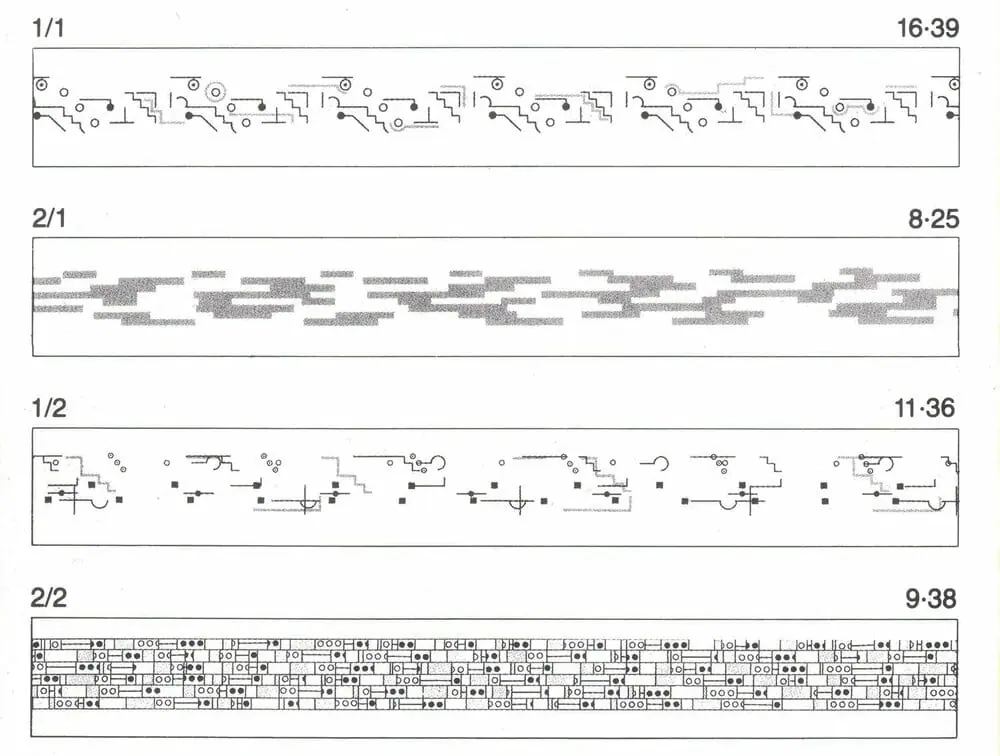
In Techno music, we often may be using similar if not the same tools as used in Ambient music. Whether it be pads, lead synths, or found sound samples, each often stems from the same tempo, the same clock. But where Ambient focuses on the saturation and blending of the elements, with a heavy emphasis on wet effects and slow tempo, Techno provides rigidity between the sonic elements. The kick drum is very clearly in one generative lane, the bass in another, etc. Where wetness in FX can be applied for dynamic emphasis, to oversaturate Techno instrumentation would risk taking the emphasis away from the rhythm and the pulse at its root. I can’t hear that *CLAP* if it’s too wet!
Both styles contain the same core elements, but it is through their differences in saturation and pulse that we can arrive at one ballpark over another.
In contemporary electronic music composition, both Ambient and Techno production relies heavily on generative instruments, such as sequencers and arpeggiators. Most fixed architecture generative instruments allow for set pattern lengths, often set to 8 or 16 steps per sequence. To achieve the Meter of Nowness with generative electronic instruments, regardless of aesthetic styling, we need to replace fixed-step sequences with controlled randomization.
While you won’t find me tooting the modular synthesis horn too often, one thing that modular does right is create opportunities for expressive randomness. In the case of this demonstration, I have created four figures demonstrating various generative music techniques, each of which is based on a virtual Eurorack patch created in VCV Rack. The theory applies to any non-fixed architecture generative instrument, so as long as controlled randomization is possible. My suggestion before buying several thousand dollars worth of modular gear is to create your own test versions of the following signal flows using free or open-source virtual modular software, such as VCV Rack, Puredata, Supercollider, or TidalCycles.
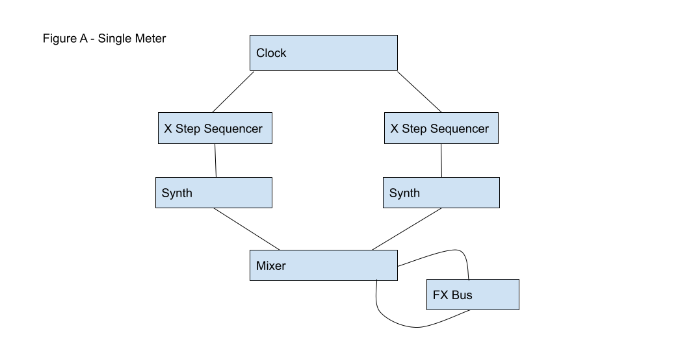
In Figure A we see a standard signal flow of generative instrumentation often seen in modular rigs. A single tempo stems from one clock module, acting as the “brain” of our generative patch, which triggers two or more Step Sequencers set to 16th note divisions of the same meter, often set to a 4/4 meter by mechanical default. This signal flow is perfect for four-to-the-floor drum sequencing, basslines, and following a general pop structure as far as the meter is concerned. This signal flow is applicable well beyond Techno and Ambient music, our entire pop vocabulary tends to revolve around four.
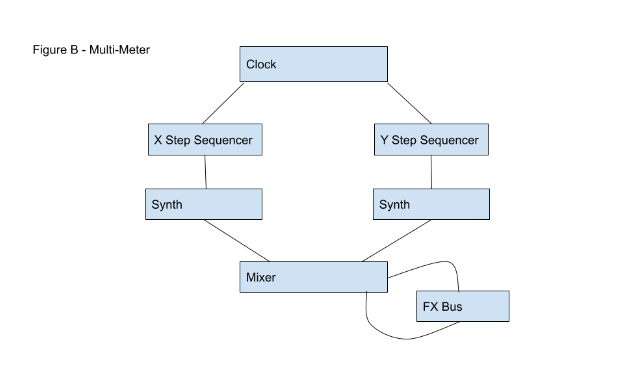
In Figure B we see almost the same signal flow, all materials will remain generated by a single clock. The change occurs through the implementation of multiple meters, as demonstrated by setting the Step Sequencers at two or more individual meters. By allowing for multiple tracks of rhythmic phrases, such as a snare in 6/8 over a kick drum in 4/4, we enter a state of simple phasing a la Steve Reich, which is just a Westernization of polyrhythmic techniques heard in West African percussion.
In the case of a 3 over 4 polyrhythm, the initial downbeat at 1 doesn’t repeat until after the 12th pulse, allowing much room for interpretation as to what path to follow when applied to either Techno or Ambient. It’s through these large potential spaces between downbeats that the listener must decide which path they choose to take, which sound will be considered “lead” over “accompaniment”, and which meter they choose as the primary grid to move and groove to.
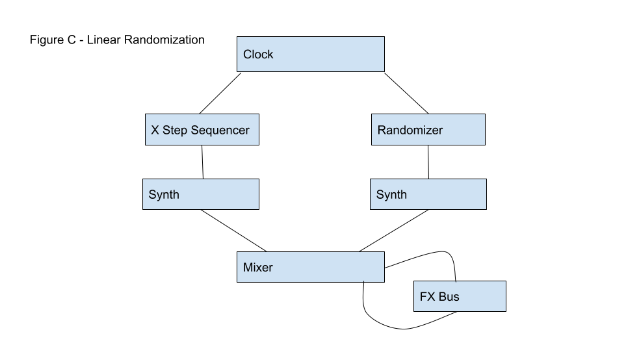
In Figure C we see the introduction of randomness by removing one or more of the Step Sequencers and replacing them with a Clock controlled Randomizer, or random sequence generator. A Randomizer receives a steady pulse and generates random patterns through voltage-controlled settings determined by the composer. It is one of the most efficient tools to achieve chance encounters in the contemporary electronic music workspace. The result is a combination of set meter and loopable sequences on one instrument and a constantly generating series of rhythmic phrases that never repeat themselves on the other instrument.
In many ways, this is a sort of digital rendering of a linear drumming technique, a a Gospel and Jazz term referring to when combinations of individual drum hits are played monophonically in a constantly shifting order that functions as a groove without relying on repeating pre-determined bar-length patterns as one usually does. The technique has been applied several times in electronic music as well, most notably heard in Aphex Twin’s pivotal productions in the late 1990s and early 2000s. Think about the first time you hear the drums in “Windowlicker”. There’s not a single drum phrase in that introduction that repeats itself in the same way until we finally reach the hook.
One can consciously and meticulously program their drums in this linear fashion a la Richard D. James, or you can set a patch in motion to create these differentiating monophonic phrases through generative randomization.
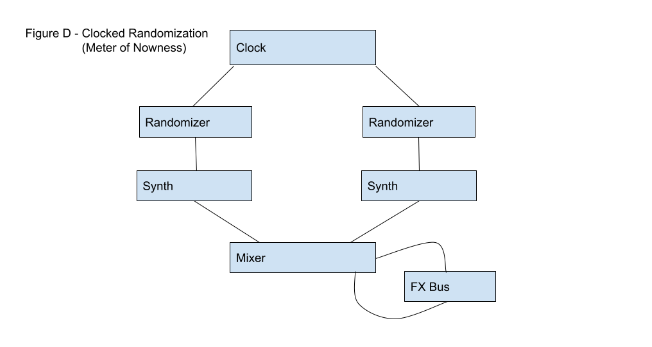
In our final diagram above, we have removed all Step Sequencers entirely and have replaced all pattern generator roles with Randomizers. There is no conceivable meter beyond the Clock at the motherboard sending in voltage one single tempo pulse at a time. Each Randomizer can be given its custom limitations to create variation amongst the instruments, such as limiting pitch registers or subdivisions for long tones versus short tones, or the inclusion of swung and triplet pulse randomizations to create variation in the rhythmic grid phrasing. But what is left is simply a controllable clocked randomization, there is only one meter by common denominator and it stems from the individual pulse controlling everything beneath it: The Meter of Nowness. There is only the one.
You’ll notice I haven’t mentioned genre or aesthetic much when regarding any of these signal flow diagrams as a whole, I simply created techno examples as just one avenue for Clocked Randomization. We can create generative dance music using all of the above just as much as we could create spacious long tone soundscapes. Oftentimes the only difference between the many subgenres of generative electronic music is simply the way we arrange the signal flows regarding tempo and FX saturation. As previously mentioned above, these examples of signal flow can help us achieve our color palette, but it’s through our decision-making when we put paint to canvas that actual compositional and aesthetic choices are made. Use common sense: if you're making music to dance to, it tends to be faster in tempo than music to sleep to.
I’ll say it again: I’m not reinventing any wheels here. Chance and open-ended metric structures in music have existed for centuries across six continents. What this theory and explanation serves to do is provide an efficient means for contemporary electronic musicians to tap into that live “nowness” when seeking new generative rhythmic ideas.
It’s 2023, and we are tied to the DAW grid and the loops we make within it. By removing the predetermined pattern length and loopability from our electronic instruments, be it hardware or software, it forces us as composers not to think in terms of the macrostructure set before us in the grid. We can become improvisers of generative music through the aid of chance. We can create, listen, dance, and absorb ourselves in the nowness of the pulse.
“Early in the journey, you wonder how long the journey will take and whether you will make it in this lifetime. Later you will see that where you are going is HERE and you will arrive NOW...so you stop asking.”
― Ram Dass, Be Here Now
Max Alper aka La Meme Young is a music teacher, writer, and is the co-founder of Klang Magazine. He makes music under the moniker Peretsky. He currently serves as Adjunct Lecturer at the Conservatory of Music at Brooklyn College, and the New York Film Academy.
